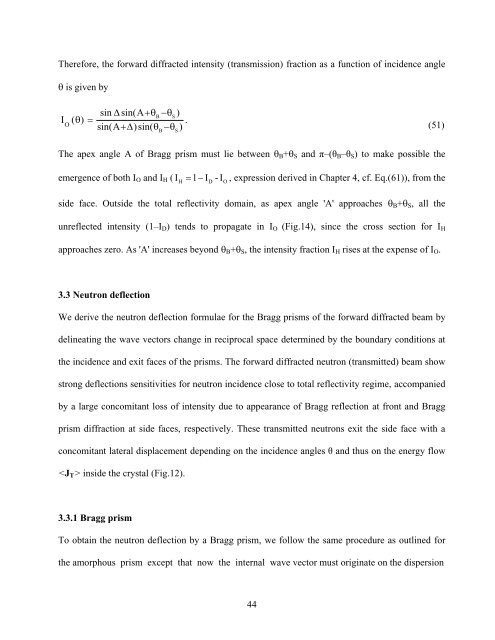PHYS01200804001 Sohrab Abbas - Homi Bhabha National Institute
PHYS01200804001 Sohrab Abbas - Homi Bhabha National Institute
PHYS01200804001 Sohrab Abbas - Homi Bhabha National Institute
You also want an ePaper? Increase the reach of your titles
YUMPU automatically turns print PDFs into web optimized ePapers that Google loves.
Therefore, the forward diffracted intensity (transmission) fraction as a function of incidence angle<br />
is given by<br />
sin sin(A )<br />
(51)<br />
B S<br />
I ( ) <br />
.<br />
O<br />
sin(A )sin(<br />
B S<br />
)<br />
The apex angle A of Bragg prism must lie between B + S and π–(θ B –θ S ) to make possible the<br />
emergence of both I O and I H ( I H<br />
1<br />
I D<br />
- I O<br />
, expression derived in Chapter 4, cf. Eq.(61)), from the<br />
side face. Outside the total reflectivity domain, as apex angle 'A' approaches B + S , all the<br />
unreflected intensity (1–I D ) tends to propagate in I O (Fig.14), since the cross section for I H<br />
approaches zero. As 'A' increases beyond B + S , the intensity fraction I H rises at the expense of I O .<br />
3.3 Neutron deflection<br />
We derive the neutron deflection formulae for the Bragg prisms of the forward diffracted beam by<br />
delineating the wave vectors change in reciprocal space determined by the boundary conditions at<br />
the incidence and exit faces of the prisms. The forward diffracted neutron (transmitted) beam show<br />
strong deflections sensitivities for neutron incidence close to total reflectivity regime, accompanied<br />
by a large concomitant loss of intensity due to appearance of Bragg reflection at front and Bragg<br />
prism diffraction at side faces, respectively. These transmitted neutrons exit the side face with a<br />
concomitant lateral displacement depending on the incidence angles θ and thus on the energy flow<br />
inside the crystal (Fig.12).<br />
3.3.1 Bragg prism<br />
To obtain the neutron deflection by a Bragg prism, we follow the same procedure as outlined for<br />
the amorphous prism except that now the internal wave vector must originate on the dispersion<br />
44
















